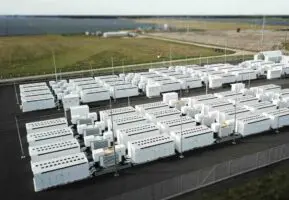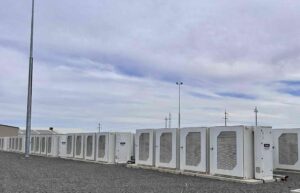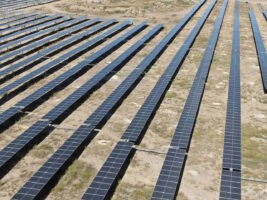(See also: Why $100 billion invested in wind and solar will produce more energy than oil).
A major new report says Big Oil’s business model is waning, and the world’s oil majors should start directing much more capital to renewable projects, so they can be the “energy majors” of the future, rather than ending up as the oil majors of the past.
The report by Mark Lewis, from leading French investment bank Kepler Chevruex, says it is now clear that the business model of Big Oil is already being eroded by rising capital intensity and diminishing returns. In other words, oil companies are having to spend more money finding oil, and getting less for it when they do exploit it.
And in the future, Big Oil is facing much greater competition from renewable energy in the road-transportation market – particularly in China, where billions are being invested in Electric Vehicles and charging networks – much of which will be powered by wind and solar. Indeed, $100 billion invested in wind or solar will produce more net energy yield than the same amount invested in oil, according to its research.
“At the same time, the threat of tighter environmental and climate legislation at a global, regional, and national level is always looming in the background and pressure for more concerted climate-policy coordination will in our view only increase in future,” Lewis writes.
“As a result, we think they should already start directing much more of their future capital investments to renewable projects. This would enable them to become the energy majors of the future rather than ending up as the oil majors of the past.”
This is by no means the first report that speculates about the peak in the Big Oil business model. Earlier this year, Alliance Bernstein, the conservative US investment firm, warned of the impact of “energy price deflation”, pointing to the plunging cost of solar and its ability to slowly, but quite steadily, erode volumes and margins in liquid fuel markets such as diesel in Middle East and third world, LNG in Asia, and gas in developed economies. The IEA has warned of peak oil demand by 2020, others such as HSBC and Carbon Tracker have warned of tens of trillions in potential stranded assets.
Lewis, from Kepler Chevreux, agrees with Alliance Bernstein that falling oil prices are rapidly increasing the risk that high-cost oil projects will become stranded in future. It notes that the price of oil is already down $US20/bbl (Barrel) since June on demand worries and further falls are likely.
But Lewis says there is another dimension to stranded-asset risk, largely ignored in the debate so far – “namely the risk posed by a scenario of sustained higher oil prices over the longer term.”
That’s because its analysis shows that renewables are already surprisingly competitive with marginal new oil projects. “And with renewables set to see further cost reductions over the next two decades, higher long-term oil prices will be no guarantee against asset-stranding beyond 2025 for marginal new projects.”
Lewis says that even conservative oil demand forecasts such as those from the International Energy Agency – which sees global oil demand rising 14mbd by 2035 – ignores the improving economics of renewables versus oil.
And it does not take into account a faster take-up of EVs in China, which could threaten the viability of the marginal barrels beyond 2025. Around one-third of the IEA’s forecast increase in oil demand comes from an assumed growth in petrol-consuming light vehicles.
Lewis says that based on his calculations, solar and wind will deliver more energy per dollar invested than oil. (See our full report here). That means that the IEA oil forecasts might have to be radically revised.
Lewis, however, agrees with the Sanford Bernstein analysis that the prospect of either declining oil prices, or the inability of high oil prices to compete with cheaper renewables, will trigger a dramatic change in the flow of capital.
“We think the traditional rules of the global energy system are now being upended as the world begins to transition away from fossil fuels towards a more sustainable future system based much more on renewable energy,” Lewis writes.
“And although this transition will take decades to be fully realised, the key point is that higher oil prices will only serve to accelerate it, not least because – in stark contrast to those of the oil industry – the costs of renewable-energy technologies will continue to fall over time.
“This means that far from vouchsafing the future profitability of the higher-cost, high- carbon investments that the oil majors might make over the next decade, sustained high oil prices could actually lead to such investments becoming stranded beyond 2025 as the question of oil’s affordability relative to renewables comes into ever sharper focus. “
Lewis notes that the upstream oil industry’s capital intensity has already increased astronomically over the last decade. This is due to the massive annual investments now required in order to replace declining output in ageing conventional fields, to counter the phenomenally high decline rates in US shale-oil plays, and to add supply over and above replacement levels so as to meet growing global demand.
He also notes that despite the record recent levels of upstream capex since 2005, this has fed through into only very modest increases in the total oil supply (and have not been able to prevent a decline in the supply of conventional crude oil).
And, Lewis notes, that rising costs associated with the industry’s increasing capital intensity have run ahead of prices since 2011. This has led to a fall in the oil majors’ capital productivity and hence to cuts in their capex budgets since the beginning of this year.
“Here’s the catch: other things being equal, the steeper the upward trajectory for oil prices into the future, the greater will be the incentive to accelerate the deployment of renewable-energy technologies, especially as the cost trajectory for renewables is falling not rising,” Lewis writes.
“And as the producers of the marginal barrels in the global oil market who are making new investments today at the higher end of the cost curve to secure production beyond 2025, the oil majors will in our view be increasingly vulnerable to competition from the falling cost of renewable-energy technologies in that timeframe.”
But, Lewis adds, the oil majors remain “very complacent” about the potential impact of future climate legislation, and “almost completely oblivious to the risk to their business model posed by rising oil prices and the increasing competitiveness of renewables.
“It is the aim of this report to explain why the majors should be thinking much more seriously about the risk of stranded assets even under a scenario of rising and sustained high oil prices, and hence why they should be very cautious in particular about new investments in high-cost, high-carbon projects.”










